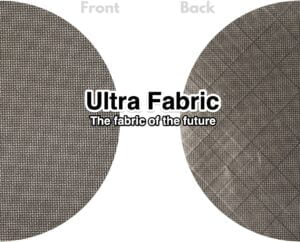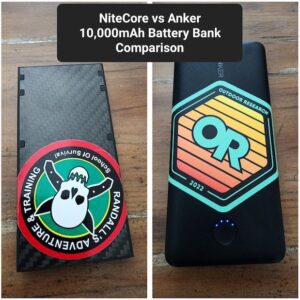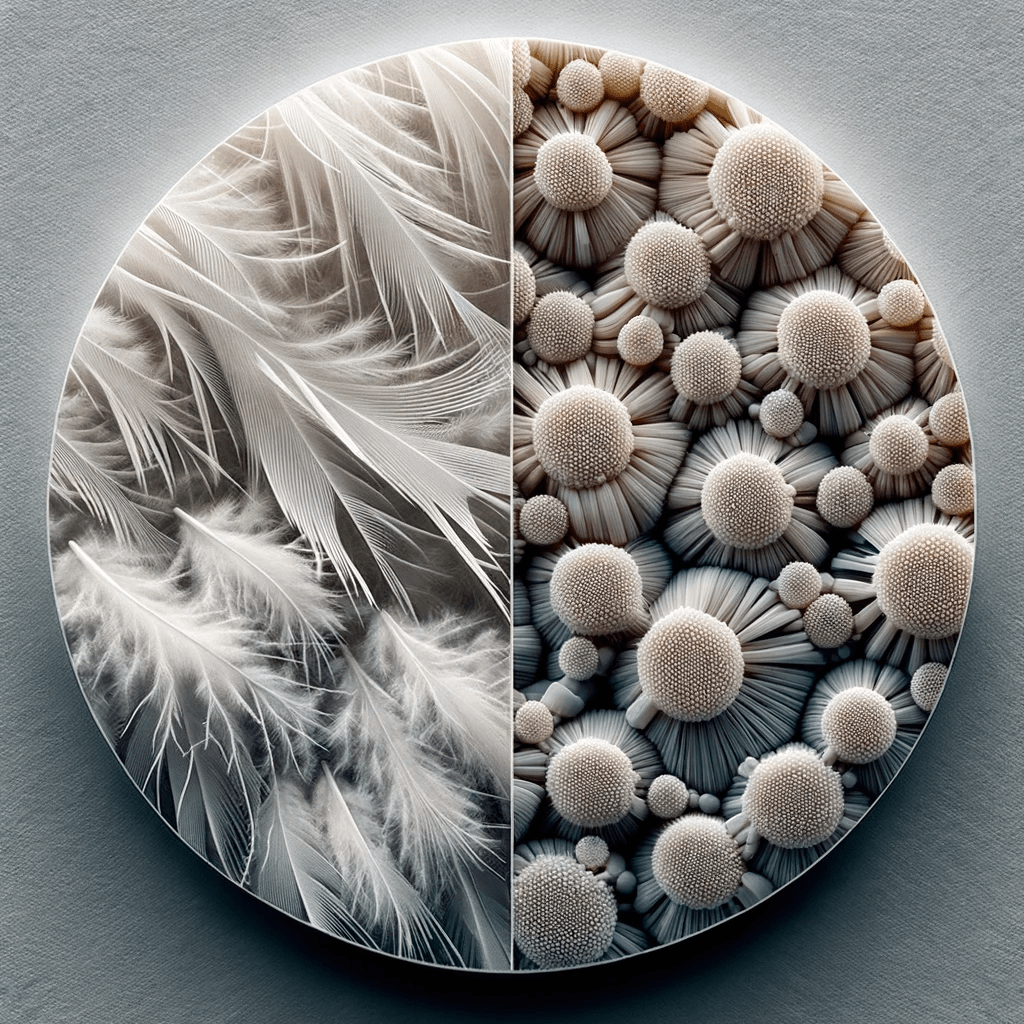
Copyright: ULGearBlog.com - A photo of a magnified view of down feathers on the left and synthetic fibers on the right. The down feathers have a soft, intricate structure, while the synthetic fibers are more uniform and structured.
Choosing down versus synthetic insulation for outdoor gear like sleeping bags, sleeping quilts, jackets, booties (for your feet), or gloves is crucial. The right decision ensures you remain warm, comfortable, and enjoy your time outdoors. In this article, we’ll dissect the intricate details of down and synthetic insulation, including their pros, cons, and the innovative blends manufacturers are now employing.
Delving Deeper into Down Insulation
Contrary to popular belief, down insulation isn’t derived from bird feathers but from the soft, fluffy plumage found beneath the exterior feathers of waterfowl, like ducks and geese. This under-feathering consists of light, wispy filaments, which are distinct from regular feathers.
Advantages of Down Insulation:
- Remarkable Warmth-to-Weight Ratio: Down surpasses synthetic insulation in offering warmth for its weight.
- Impressive Compressibility: Ideal for those aiming to save space and reduce weight.
- Superior Durability: With meticulous care, a down-filled jacket or sleeping bag can serve for numerous years.
- Variability in Down Sources: Traditionally, geese were the primary source, but due to rising costs, manufacturers are now also harnessing duck down. Regardless of the source—be it duck or goose—the performance and testing standards remain consistent. That said, it’s common to find goose down in premium products due to its ability to achieve a higher fill-power rating.
Fill Power – Decoding the Term:
Fill power measures down’s lofting ability, which correlates with its heat-trapping capacity. It represents the cubic inches one ounce of down occupies. For instance, 600-fill-power signifies that one ounce fills 600 cubic inches. While premium goose down can achieve up to 900 fill-power, duck down typically maxes out between 750 and 800.
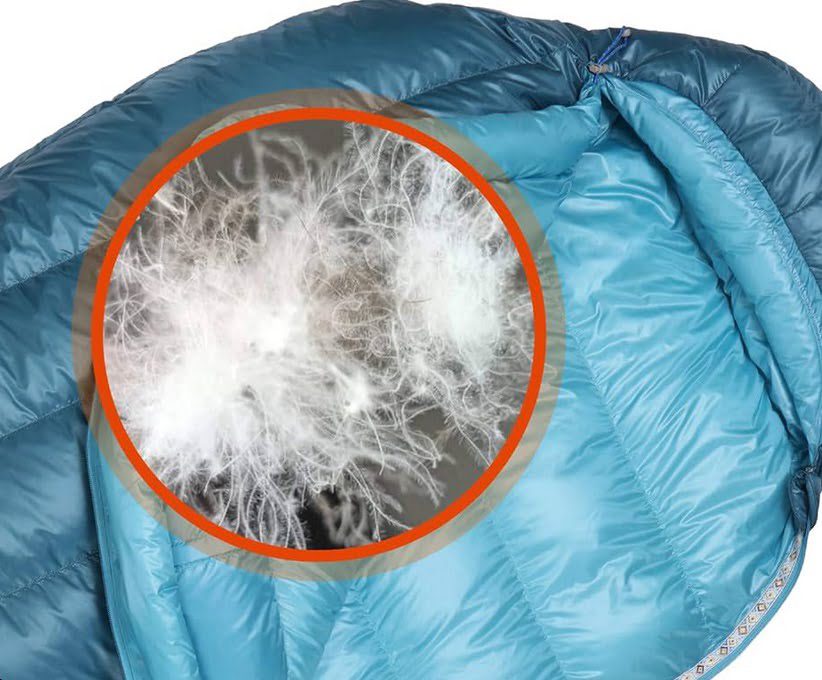
Disadvantages of Down:
- Moisture Sensitivity: The major shortcoming of down is its vulnerability to moisture. When wet, it tends to clump, losing its insulative properties. Though recent technologies have enhanced down’s water resistance, it’s still paramount to shield down items from excessive wetness.
- Care Requirements: Down items necessitate specialized cleaning methods.
- Allergen Concerns: Some individuals might be allergic, though this is a rare occurrence.
- Cost: Down products tend to have a higher price point than synthetics.
Synthetic Insulation Unveiled
Predominantly composed of polyester, synthetic insulation stands out for its quick drying properties and ability to insulate even when damp. This man-made insulation also boasts durability, hypoallergenic properties, and a more wallet-friendly price tag compared to down.
Synthetic Insulation Categories:
There’s a multitude of brand names for synthetic insulations, but categorically, they can be bucketed into:
- Short-Staple Insulations: These have short, fine-denier filaments densely packed, giving products a down-like feel and superior compressibility. However, they can sometimes shift, leading to cold spots.
- Continuous-Filament Insulations: These insulations, with their thicker, sturdy filaments, are robust and enduring. They’re less compressible than short-staple insulations but are adept at maintaining an even warmth distribution.
Advantages of Synthetic Insulation:
- Water-Resistance: Retains insulating capabilities even when damp.
- Allergen-Free: Suitable for those with down allergies.
- Budget-Friendly: Typically comes with a lower price tag compared to down.
Disadvantages of Synthetic Insulation:
- Weight and Bulk: Generally heavier and less compressible than down.
- Warmth Limitation: Provides less warmth for its weight in comparison to down.
- Durability Concern: Over time and with repeated compression, its insulating power can diminish.
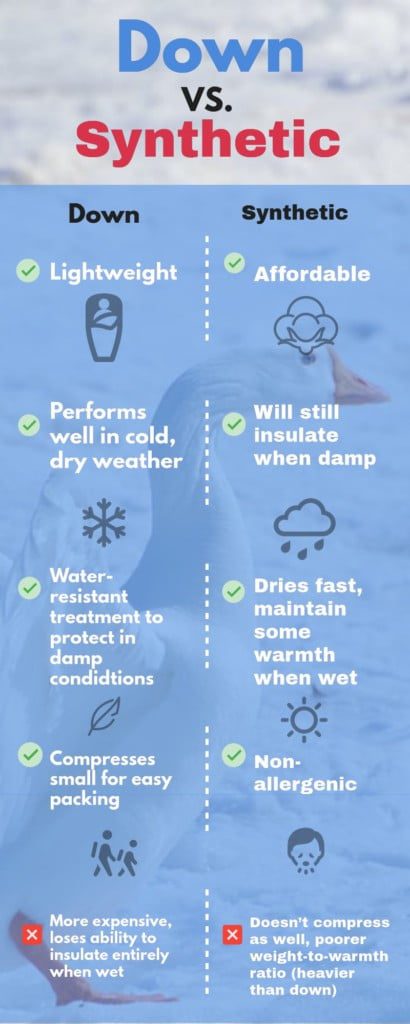
The Fusion: Down/Synthetic Blends
Several manufacturers have championed a hybrid construction, blending water-resistant down with synthetic insulation. This ingenious amalgamation captures the strengths of both materials while minimizing their individual drawbacks.
Advantages of Down/Synthetic Blends:
- Weight and Compressibility: Offers a middle ground, being lighter and more compressible than pure synthetic but slightly heavier than pure down.
- Cost Efficiency: More affordable than pure down but slightly pricier than pure synthetic.
- Moisture Resilience: Combines the water-resistance of synthetic with the loft of down.
Disadvantages of Down/Synthetic Blends:
- Comparative Weight: Heavier than pure down products.
- Water-Resistance: Less resistant than pure synthetic.
- Cost: Pricier than pure synthetic insulation.
Table 1: Comparison of Down vs Synthetic for Jackets
| Feature | Down | Synthetic |
|---|---|---|
| Warmth-to-Weight | Excellent | Good |
| Compressibility | High | Moderate |
| Moisture Performance | Poor (unless treated) | Good |
| Lifespan | Long (with care) | Shorter |
| Maintenance | Specialized care | Easier |
| Cost | Typically Higher | More affordable |
Table 2: Comparison of Down vs Synthetic for Sleeping Bags/Quilts
| Feature | Down | Synthetic |
|---|---|---|
| Warmth-to-Weight | Excellent | Good |
| Compressibility | High | Moderate |
| Moisture Performance | Poor (unless treated) | Good |
| Lifespan | Long (with care) | Shorter |
| Maintenance | Specialized care | Easier |
| Cost | Typically Higher | More affordable |
Environmental Impact and Ethics of Down vs Synthetic
An often overlooked but vital aspect of choosing between down and synthetic insulation is the environmental and ethical implications.
Down:
- Ethical Concerns: The down industry has faced criticism over animal welfare concerns. It’s essential to look for certifications like the Responsible Down Standard (RDS) to ensure the down is ethically sourced.
- Environmental Impact: Down, as a natural material, is biodegradable. However, the process of raising geese or ducks can have environmental implications, including water usage and waste.
Synthetic:
- Environmental Impact: Most synthetic insulations are derived from petrochemicals, which are non-renewable resources. However, there’s a growing trend in using recycled materials for synthetic insulation, reducing its environmental footprint.
Lifespan and Long-Term Performance
Down:
- Over an extended period, with proper care, down insulation retains its loft and insulating properties far longer than synthetic insulation.
Synthetic:
- While it may start strong, synthetic insulation tends to degrade faster, especially with regular compression and use.
Down vs Synthetic Maintenance and Care
Down:
- Requires specialized washing detergents.
- Needs to be dried thoroughly to prevent mold and maintain loft. Using dryer balls can help restore loft after washing.
Synthetic:
- Generally easier to clean, and can usually be washed with regular detergents.
- Dries faster than down, reducing mold risks.
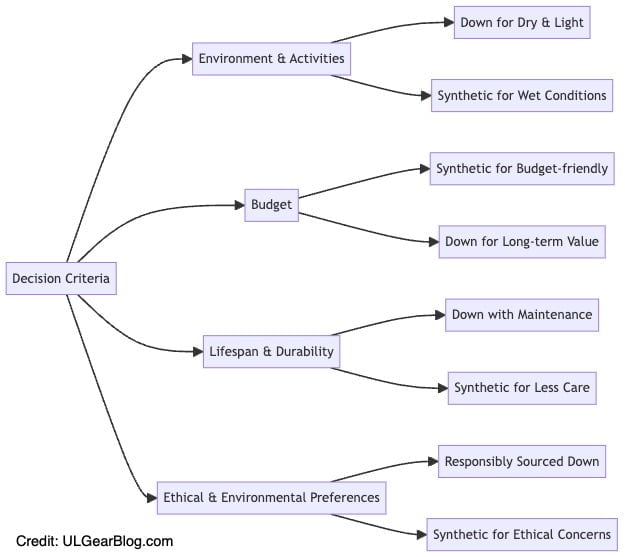
Wrapping Up
Your choice of insulation should align with your outdoor ventures, weight considerations, probable weather conditions, and budget. It’s imperative to make an informed decision to ensure your outdoor experience is unparalleled. Whether it’s a sleeping bag for mountain expeditions or a jacket for chilly hikes, pick the right insulation, and enjoy your adventure!
